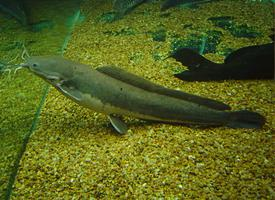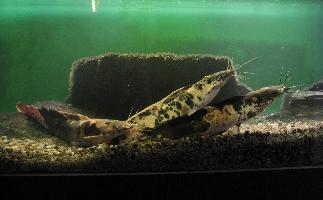
Známé také jako
- Keříčkovec jihoafrický
- Sumčík africký
Váhy a míry
| Délka | od 1 do 1,5 m |
|---|
Popis zvířete
The African sharptooth catfish, scientifically named Clarias gariepinus, is a fascinating species of freshwater fish that holds a prominent place in both the ecosystem and human culture across the African continent and beyond. This species is not only known for its remarkable adaptability and resilience but also for its significant role in aquaculture and subsistence fishing.Physically, the African sharptooth catfish possesses a number of distinctive features that set it apart from other fish species. It has a long, slender body that can grow up to an impressive length of about 1.7 meters (5.6 feet) and weigh as much as 60 kilograms (132 pounds), though typical specimens are much smaller. Its skin is smooth and scaleless, covered in a layer of mucus that helps it to navigate through muddy waters. The coloration of this catfish varies from a dark grey to a brownish hue on the dorsal side, gradually transitioning to a lighter, almost white underbelly. This natural camouflage aids in its predatory habits and protection from predators.
One of the most striking features of the African sharptooth catfish is its mouth, equipped with a set of sharp, conical teeth. These teeth, along with a powerful jaw, enable it to feed on a wide variety of prey, including fish, crustaceans, and even small birds or mammals that venture too close to the water's edge. The catfish's diet is opportunistic, allowing it to thrive in diverse aquatic environments.
Another notable adaptation of Clarias gariepinus is its ability to breathe atmospheric air. Thanks to a specialized organ called the labyrinth organ, this catfish can survive in oxygen-depleted water or even out of water for extended periods, a trait that enables it to navigate between different water bodies or survive drought conditions. This ability makes the African sharptooth catfish remarkably resilient, capable of inhabiting environments ranging from large rivers and lakes to flooded plains and small, stagnant pools.
The species also exhibits a fascinating reproductive strategy. Spawning typically occurs during the rainy season when the floodplains are inundated, providing an ideal environment for the development of the young. Females can lay tens of thousands of eggs, which are fertilized externally by the male. The high fecundity rate is crucial for the survival of the species, as it offsets the high mortality rate among juveniles.
In terms of distribution, Clarias gariepinus is native to a vast range of freshwater habitats across Africa, extending into parts of the Middle East. Its adaptability to different environmental conditions has also led to it being introduced to other regions around the world, sometimes causing ecological concerns due to its predatory nature and competition with native species.
The African sharptooth catfish has significant economic and cultural value in many African communities. It is a key species for artisanal and commercial fisheries, providing a vital source of protein. Additionally, its hardiness and rapid growth make it an ideal candidate for aquaculture, where it is farmed extensively for food.
However, like many species, Clarias gariepinus faces threats from habitat destruction, pollution, and overfishing. Conservation efforts and sustainable management practices are essential to ensure the continued abundance and ecological role of this remarkable species in its native and introduced ranges.
In conclusion, the African sharptooth catfish is a species of remarkable biological interest and economic importance. Its ability to adapt to a wide range of environmental conditions, combined with its significant role in the food web and human society, makes it a subject of ongoing study and admiration.
Podobná zvířata
Nové fotografie zvířat
Top 10 zvířat
- Chinese water dragon (Physignathus cocincinus)
- Galápagos tortoise (Geochelone nigra complex)
- Dolphin gull (Leucophaeus scoresbii)
- Japanese macaque (Macaca fuscata)
- Colombian red howler (Alouatta seniculus)
- Sea urchins (Echinoidea)
- Moustached guenon (Cercopithecus cephus)
- Diana monkey (Cercopithecus diana)
- Common reed warbler (Acrocephalus scirpaceus)
- Common house mosquito (Culex pipiens)
